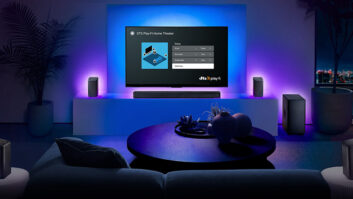WASHINGTON— The Federal Communications Commission (FCC) unanimously approved rules for digital cable plug-and-play interoperability between digital cable services and consumer electronics products.
The decision came just in time for television manufacturers to begin plans for the production of 2004 HDTVs, which can now add digital-cable-ready capability. The ruling will eliminate the need for separate set-top boxes and makes it possible for a TV set to be transported from one cable market to another with the assurance that it will work with any digital cable system.
“This represents another enormous advance in the high-definition television transition,” said FCC Chairman Michael Powell. “We now will be able to have high-definition television sets that people can more readily bring home and connect to the systems that are delivering high-definition content.”
Responding to the FCC’s action, Gary Shapiro, Consumer Electronics Association president, said “history books will mark this as a momentous day in the U.S. transition to digital television. That sound you hear is the excited rumblings of millions of consumers preparing to join the HDTV era now that plug-and-play is a reality.”
Robert Sachs, National Cable & Telecommunications Association (NCTA) president, hailed the decision. “The FCC’s endorsement of these agreements sends a positive signal to all involved in the DTV transition to work together to voluntarily resolve outstanding issues.”
As the CE industry plans next year’s digital TVs many will be required to incorporate ATSC digital over-the-air tuners in compliance with an earlier FCC tuner mandate, and many manufacturers were eager to add the new cable compatibility to these premium offerings.
The ruling will also enable two manufacturers — Panasonic and Hitachi — to deliver the first “digital-cable-ready” HDTV sets this fall. Both manufacturers committed early on to introduce the first digital-cable-ready products and rolled the dice that the FCC would approve an agreement between the manufacturers and the cable industry.
The rules cover a base-level uni-directional cable interoperability system, consisting of two major parts: the first covers how cable operators send their signals to receiving products. The second covers encoding rules for the use of that content in the home.
Additionally, the agreement specifies the use of conditional-access security cards, called Point of deployment modules or “CableCARDs.” Cable operators will provide purchasers of digital cable ready TV sets with a Cable CARD to enable viewers to access scrambled premium channels to which they have subscribed.
The approved plug-and-play rules provide for the use of two different digital interfaces, IEEE-1394 with DTCP and DVI or HDMI with HDCP as well as HD component video inputs, which accept broadband analog video signals. Sets labeled as digital-cable-ready will be required to have connectors for DVI/HDMI with High-bandwidth Digital Content Protection (HDCP).
The encoding rules also address digital content rights management and were modeled on the Digital Millennium Copyright Act, which designates copy-never rules for pay-per-view and video-on-demand content, copy-once rules for basic cable channels and places no restrictions on broadcast stations.
The approval amended only slightly the agreement reached by the consumer electronics manufacturers and the cable television industry last December. It will be subject to review if a party petitions the commission for special relief.
Ken Ferree, FCC media bureau chief, said the plug-and-play rulemaking “was not just a rubber stamp of the agreement that was presented to us by the cable and consumer electronics industries.”
He said the rules passed by the FCC amended the original CE/cable agreement to consider concerns from industries including content-rights holders, broadcasters, direct-to-home satellite providers and the PC industry.
Examples of changes from the original agreement cover the handling of subscription video-on-demand (SVOD) services in home recording, and the extent to which “selectable output controls may someday in the future be used.”
In response to a late request to the FCC from the Starz Encore Group that content-management rules covering SVOD be changed from “copy-once” to “copy-never,” Ferree said the rules treat SVOD as “an undefined business model.” That means that SVOD content “can be treated any way the content owner wants it to be treated, subject to complaint.”
The use of selectable output controls came in response to concerns from Hollywood studios which, in part, were looking to safeguard their content from illicit duplication over unrestricted signal pathways, such as analog HD component video outputs, which have been dubbed “the analog hole.”
Ferree said “Hollywood interests” have stated they are not interested in using selectable output controls now, it is just that at some future time they may be useful for closing the analog hole or for encouraging the development of new and innovative business models.”
The approved plug-and-play rules also added a requirement that all digital-cable-ready TV sets include over-the-air ATSC tuners, in accordance with the FCC’s earlier digital tuner mandate, and cleared the way for the development of digital cable ready computers with the understanding those devices protect the security of content. It also left open for further comment the way new technologies could be approved under the rules.
Ferree said, “at the end of the day I think [content-rights holders] are going to be happy with this. They are going to have new ways to distribute their content in new and exciting ways. This will be good for consumers and good for the content owners.”
Richard Lewis, Zenith senior VP, said, “In addition to providing for plug-and-play cable reception, the new regulations address the importance of free over-the-air HDTV by also requiring broadcast DTV tuners in sets labeled as ‘digital cable ready.”
Lewis, who worked with the team of DTV manufacturers that negotiated the plug-and-play agreement with cable multiple system operators, said Zenith’s parent company, LG Electronics, is preparing to introduce digital-cable-ready HDTVs in the first half of 2004.
Ed Wolff, Panasonic display group merchandising VP, said the action “validates the direction we set for ourselves months ago, when we initially signed our version of the agreement with CableLabs.” He added, that the FCC’s amendments to the plug-and-play agreement would not impact the performance of the digital cable-ready televisions his company will begin selling at the end of the month.
The satellite-television industry, which was not a party to the plug-and-play agreement talks between TV makers and cable operators, took issue with the FCC’s action.
In a statement, the Satellite Broadcasting and Communications Association (SBCA) said its industry’s exclusion from “the negotiation process only limits all players in the multichannel market to a lower cable standard, instead of raising the standards and quality of cable to those of the DBS industry.”
SBCA added it does not consider it the “end of the process” and said it is leaving open its options on the matter, pending review by its members.













